TLM
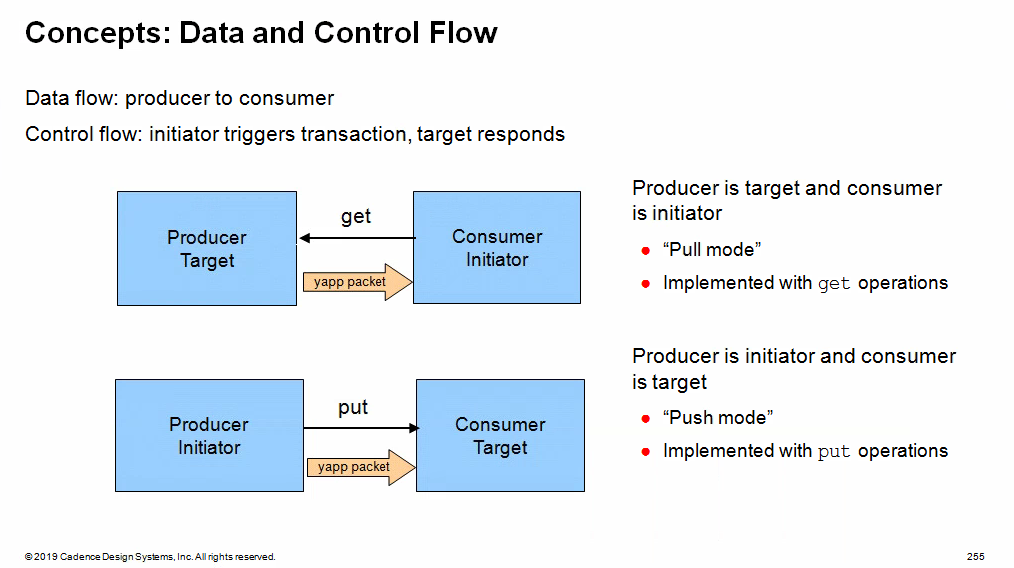
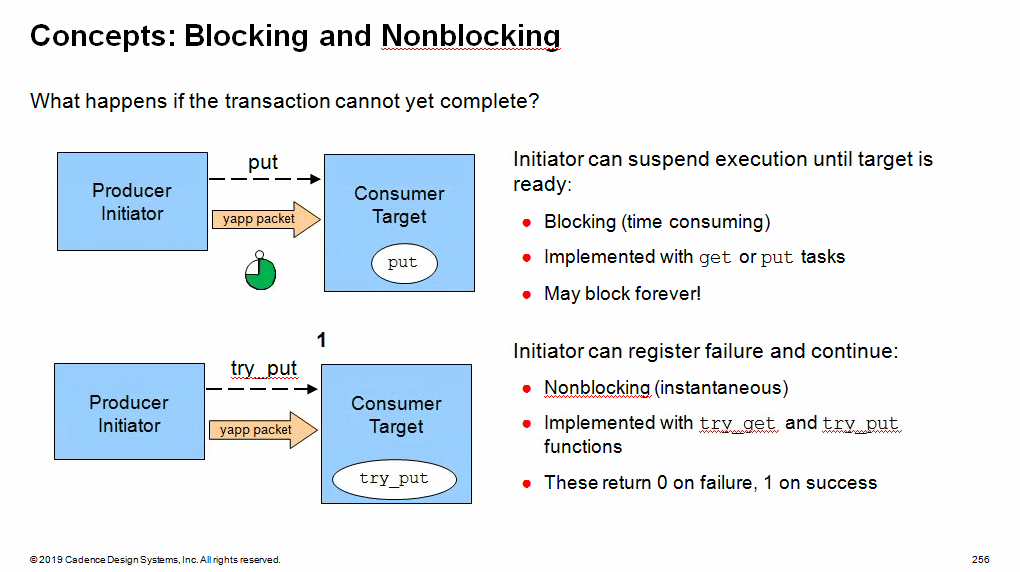
- Blocking methods are defined with
get()orput()tasks to allow them to consume time - Non-blocking methods are defined with
try_get()ortry_put()functions as they execute in zero time
Uni-Directional TLM Methods Reference
| Method | Description | Syntax |
|---|---|---|
put() |
Blocking put | virtual task put(iput TR t); |
try_put() |
Nonblocking put -return 1 if successful -return 0 if not |
virtual function bit try_put(input TR t); |
can_put() |
Nonblocking test put -return 1 if put would be successful -return 0 if not |
virtual function bit can_put(); |
get() |
Blocking get | virtual task get(output TR t); |
try_get() |
Nonblocking get -return 1 if successful -return 0 if not |
virtual function bit try_get(output TR t); |
can_get() |
Nonblocking test get -return 1 if get would be successful -return 0 if not |
virtual function bit can_get(); |
peek() |
Blocking peek | virtual task peek(output TR t); |
try_peek() |
Nonblocking peek -return 1 if successful -return 0 if not |
virtual function bit try_peek(output TR t); |
can_peek |
Nonblocking test peek -return 1 if peek would be successful -return 0 if not |
virtual function bit can_peek(); |
The
peek()methods are similarly to theget()methods, but copy the transaction instead of removing it. The transaction is not consumed, and a subsequentgetorpeekoperation will return the same transaction
Selected Connector and Method Options
put |
try_put |
can_put |
get |
try_get |
can_get |
peek |
try_peed |
can_peek |
|
|---|---|---|---|---|---|---|---|---|---|
uvm_put_* |
✓ | ✓ | ✓ | ||||||
uvm_blocking_put_* |
✓ | ||||||||
uvm_nonblocking_put_* |
✓ | ✓ | |||||||
uvm_get_* |
✓ | ✓ | ✓ | ||||||
uvm_blocking_get_* |
✓ | ||||||||
uvm_nonblocking_get_* |
✓ | ✓ | |||||||
uvm_get_peek_* |
✓ | ✓ | ✓ | ✓ | ✓ | ✓ | |||
uvm_blocking_get_peek_* |
✓ | ✓ | |||||||
uvm_nonblocking_get_peek_* |
✓ | ✓ | ✓ | ✓ |
in the connectors above,
*can be replaced byport,imp, orexportAll the methods for a specific connector type MUST be implemented. If you define an
uvm_putconnection between two compoents, then the component with theuvm_put_impobject must provide implementations of ALL three put methods,put,try_putandcan_put, even if these methods are not explicitly called
TLM FIFO
The TLM FIFO is a FIFO component wrapped in get and
put imp connectors. This has the benefit of
data storage as well as providing implementations of the communication
methods. Components connected to the TLM FIFO are in control of data
transfer and can simply defined port connectors to initiate read and
write operations on the FIFO
uvm_tlm_fifo

The TLM FIFO object is effectively a FIFO component instantiated
between and connected to two components. The FIFO contains
imp connectors for the standard TLM put and
get/peek interfaces, therefore the user does
not have to defineimp ports or communication methods and
the FIRO takes care of data storage
The advantages are:
- The user does not need to define communication methods or
impconnectors - The FIFO provides data storage between the
write(put) andread(get/peek) components - There are a number of built-in methods for checking FIFO status
The disadvantages are:
- The user must now initiate both sides of the transfer (both
get/peekandput) to complete the transaction - Two connections must be made (both sides of the FIFO) rather than one
The put_export and get_peek_export
connection objects have alternatives which provide subsets of the full
connector. For example, blocking_put_export and
nonblocking_put_export can replace put_export.
blocking_get_export, nonblocking_get_export
and get_export (as well as others) can replace
get_peek_export.
built-in methods
| Method | Description | Syntax |
|---|---|---|
new |
Standard component constructor with an additional third argument,
size, which sets the maximum FIFO size. Default size is 1.
A size of 0 is an unbounded FIFO |
function new(string name, uvm_component parent=null, int size=1); |
size |
Return size of FIFO. 0 indicates unbounded FIFO | virtual function int size() |
used |
Return number of entries written to the FIFO | virtual function int used(); |
is_empty |
Return 1 if used() is 0, otherwise
0 |
virtual function bit is empty(); |
is_full |
Return 1 if used() is equal to size,
otherwise 0 |
virtual function bit is_full() |
flush |
Delete all entries from the FIFO, upon which used() is
0 and is_empty() is
1 |
virtual funciton void flush(); |
1 | class uvm_tlm_fifo #(type T=int) extends uvm_tlm_fifo_base #(T); |
1 | virtual class uvm_tlm_fifo_base #(type T=int) extends uvm_component; |
Analysis FIFO
uvm_tlm_analysis_fifo

uvm_tlm_analysis_fifo is a specialization of
uvm_tlm_fifo
- Intended to buffer write transactions between the UVC monitor analysis port and scoreboard
It has the following characteristics:
- Unbounded (size=0)
analysis_exportconnector replacesput_export- Support the analysis
writemethod
- Support the analysis
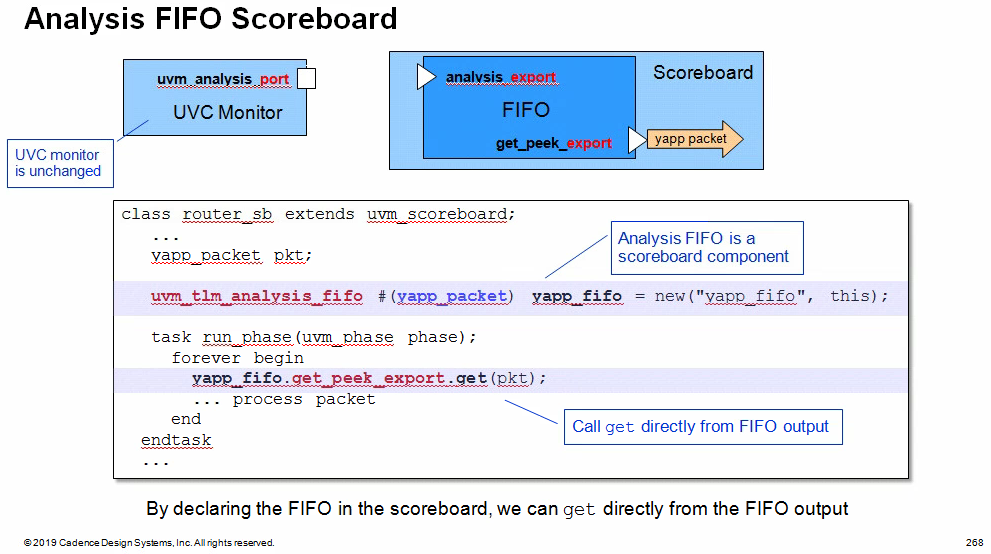
By declaring the FIFO in the scoreboard, we can
getdirectly from the FIFO output.However the write side connection of the FIFO to the interface UVC monitor analysis port must be made (usually) in the testbench which has visibility of both UVC and scoreboard components. The connection is made using a connect method call inside the connect phase method
1 | class uvm_tlm_analysis_fifo #(type T = int) extends uvm_tlm_fifo #(T); |
Analysis Port Broadcast
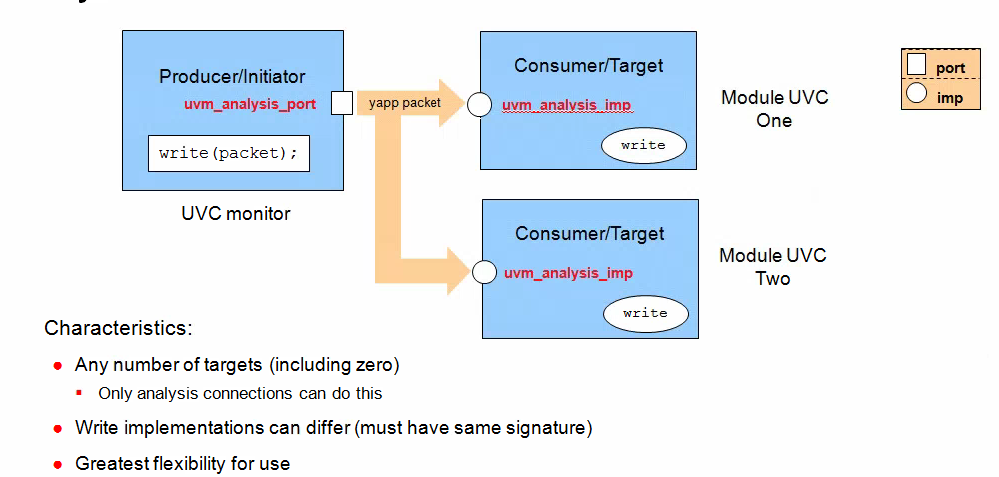
Analysis ports can (uniquely) be connected to any number of
imp connectors, including zero

The analysis port in component yapp_monitor will be connected to both monitor_one and monitor_two components. Each of the receiving components has an analysis imp object and a write communication method declared. The write method must have the same signature - i.e., they must be void functions called write with a single input argument of type yapp_packet, but their implementations can be completely different.
When the send_yapp port is connected to both
mone_in and mtwo_in imps, then a single write call
from yapp_monitor executes both write implementations in
monitor_one and monitor_two
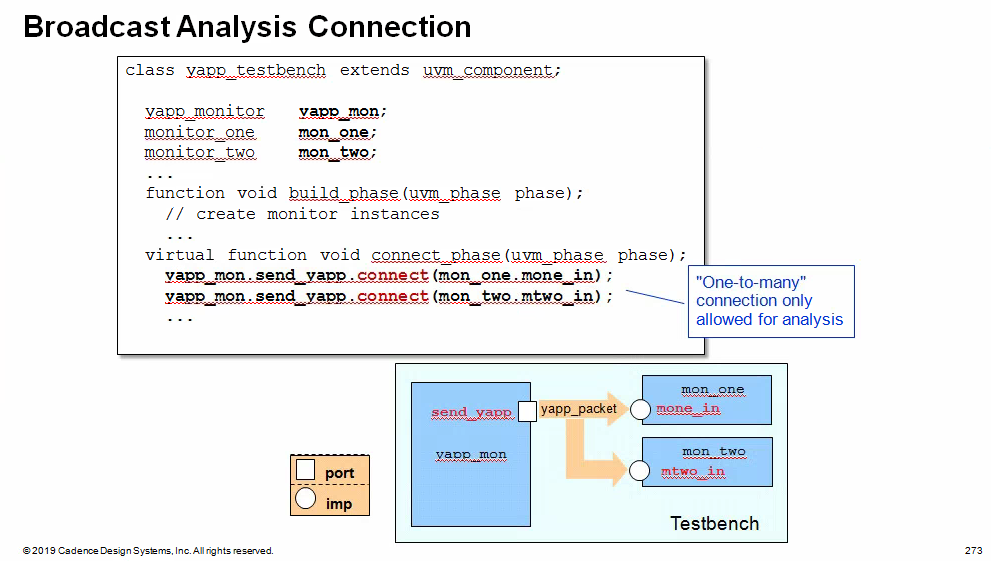
For non-analysis connections
- the TLM object must be connected to a single destination only, i.e., each non-analysis object has exactly one connect call. An object may be used multiple times as the argument to a connect, but exactly once as the caller. This is called many-to-one connection. For example, many ports can be connected to a one imp connector
For analysis connections
- a TLM object can be connected to any number of destinations i.e., one analysis object can call connect many times. This is called one-to-many connection. For example, one port can be connected to many imp connectors. one-to-many is only allowed for analysis connections. An analysis connection can also NOT call connect. An unconnected TLM object is also only allowed for analysis connections
Bi-Directional TLM Transport Connection
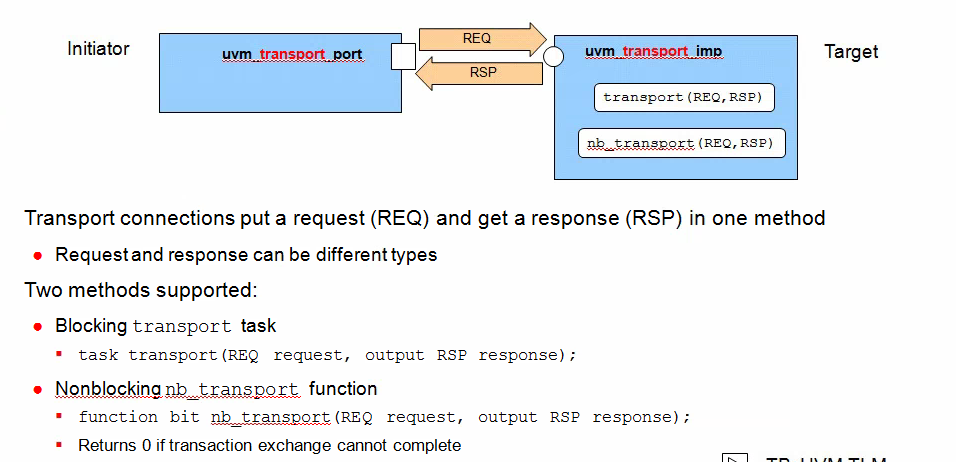
Connector syntax
1 | uvm_blocking_transport_XXX #(type REA, type RSP) |
Communication methods
1 | task transport(REQ request, output RSP response) |
Gotchas
FIFO/analysis FIFOs do not perform any cloning on input transactions. Therefore, you will need to check that the UVC monitors collect every transaction into a different instance to avoid overwriting data in the FIFOs